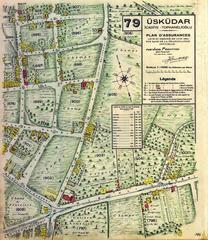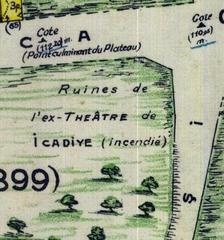
Visiting Çınarlı Cami Sokağı: History, Tips, and Visitor Information
Date: 17/07/2024
Introduction
Çınarlı Cami Sokağı, located in the heart of Istanbul, Türkiye, is a street that draws visitors with its deep historical roots, captivating architecture, and vibrant cultural life. Named after the Çınarlı Mosque, this area provides a unique window into the rich Ottoman heritage that has shaped Istanbul’s identity over centuries. The Çınarlı Mosque, built in the 16th century, stands as a testament to the architectural and cultural zenith of the Ottoman Empire, featuring intricate designs and craftsmanship that reflect the era’s artistic prowess (Turkish Museums). This guide aims to provide comprehensive information on the historical significance, architectural marvels, and socio-cultural roles of Çınarlı Cami Sokağı, along with practical tips for visitors. Whether you are a history enthusiast, architecture aficionado, or curious traveler, this guide will enrich your understanding and appreciation of one of Istanbul’s most cherished locales.
Table of Contents
- Introduction
- Historical Background
- Modern Developments
- Visitor Information
- Preservation Efforts
- Cultural Significance
- Conclusion
- FAQ
- Call to Action
Historical Background
Ottoman Era Origins
Çınarlı Cami Sokağı, located in the historic district of Istanbul, is a street steeped in rich history dating back to the Ottoman Empire. The name “Çınarlı” translates to “with plane trees,” indicative of the lush greenery that once adorned the area. The street is named after the Çınarlı Mosque, a significant religious and cultural landmark built during the Ottoman period. The mosque itself is a testament to the architectural prowess of the era, featuring intricate designs and craftsmanship that reflect the artistic and cultural zenith of the Ottoman Empire.
The Çınarlı Mosque was constructed in the 16th century, a period marked by extensive urban development and architectural innovation in Istanbul. This era saw the rise of many iconic structures, including the Süleymaniye Mosque and the Blue Mosque, which collectively contributed to Istanbul’s reputation as a center of Islamic art and architecture. The Çınarlı Mosque, though smaller in scale, is no less significant. It served not only as a place of worship but also as a community center where social, educational, and charitable activities took place.
Architectural Significance
The architectural style of the Çınarlı Mosque is a blend of classical Ottoman and Byzantine influences, a common feature in many of Istanbul’s historic buildings. The mosque’s design includes a large central dome, supported by semi-domes and arches, creating a spacious and airy interior. The use of Iznik tiles, known for their vibrant colors and intricate patterns, adds to the mosque’s aesthetic appeal. These tiles often depict floral and geometric motifs, symbolizing the Islamic art tradition of aniconism, which avoids the depiction of sentient beings.
The mosque’s minaret, a slender tower from which the call to prayer is announced, is another notable feature. Minarets are a defining characteristic of Islamic architecture, and the one at Çınarlı Mosque is particularly elegant, with its finely carved stonework and decorative elements. The mosque’s courtyard, shaded by the eponymous plane trees, provides a tranquil space for reflection and community gatherings.
Socio-Cultural Role
Throughout its history, Çınarlı Cami Sokağı has been more than just a religious site; it has been a hub of social and cultural activity. During the Ottoman period, mosques often served multiple functions, including as schools (madrasas), soup kitchens (imarets), and hospitals. The Çınarlı Mosque was no exception. It housed a madrasa where students learned various subjects, including theology, mathematics, and astronomy. The mosque’s imaret provided food for the poor and travelers, reflecting the Ottoman tradition of charity and community service.
The street itself was lined with various shops and workshops, contributing to the local economy and fostering a sense of community. Artisans, merchants, and traders would gather here, making it a bustling center of commerce and social interaction. The presence of the mosque added a spiritual dimension to the daily life of the residents, reinforcing the close-knit nature of the community.
Modern Developments
In the modern era, Çınarlı Cami Sokağı has undergone significant changes, yet it retains its historical charm. The street and its surrounding area have been subject to various urban development projects aimed at preserving their historical and cultural heritage. Efforts have been made to restore the Çınarlı Mosque to its former glory, ensuring that its architectural features and historical significance are preserved for future generations.
Today, Çınarlı Cami Sokağı is a popular destination for both locals and tourists. The street’s historical ambiance, combined with its vibrant present-day culture, makes it a unique place to explore. Visitors can admire the architectural beauty of the Çınarlı Mosque, stroll through the picturesque street, and experience the rich cultural tapestry of Istanbul.
Visitor Information
Visiting Hours: The Çınarlı Mosque is open to visitors from 9 AM to 6 PM daily, except during prayer times when it is reserved for worshippers. It is advisable to check the local prayer schedule before planning your visit.
Ticket Prices: Admission to the Çınarlı Mosque is free, though donations for maintenance and preservation are appreciated.
Travel Tips:
- Dress Code: Visitors should dress modestly, covering shoulders and knees. Women may need to wear a headscarf, which is often provided at the entrance.
- Photography: Photography is allowed in most areas of the mosque, but it is respectful to avoid taking photos during prayer times.
- Nearby Attractions: The historic district of Istanbul is home to several other significant landmarks, including the Hagia Sophia, Topkapi Palace, and the Grand Bazaar, all within walking distance from Çınarlı Cami Sokağı.
Preservation Efforts
The preservation of Çınarlı Cami Sokağı and its historical landmarks is a priority for local authorities and heritage organizations. The Turkish government, along with various non-governmental organizations, has implemented measures to protect and restore the area’s historical sites. These efforts include regular maintenance of the mosque, restoration of its architectural elements, and conservation of the surrounding environment.
One notable project is the restoration of the mosque’s Iznik tiles, which had suffered damage over the centuries. Skilled artisans have painstakingly restored these tiles, ensuring that their original colors and patterns are preserved. Additionally, the mosque’s minaret has been reinforced to prevent structural damage, and the courtyard has been landscaped to enhance its aesthetic appeal.
Cultural Significance
Çınarlı Cami Sokağı holds a special place in the cultural landscape of Istanbul. It is a living testament to the city’s rich history and diverse cultural heritage. The street and its mosque are symbols of the Ottoman era’s architectural and artistic achievements, as well as its social and cultural values. They serve as reminders of the city’s past, while also contributing to its vibrant present.
For visitors, Çınarlı Cami Sokağı offers a unique opportunity to experience Istanbul’s historical and cultural richness. The street’s blend of old and new, its architectural beauty, and its lively atmosphere make it a must-visit destination. Whether you are a history enthusiast, an architecture aficionado, or simply a curious traveler, Çınarlı Cami Sokağı promises a memorable and enriching experience.
Conclusion
In conclusion, Çınarlı Cami Sokağı is a historical gem in the heart of Istanbul. Its rich history, architectural significance, and cultural importance make it a fascinating destination for anyone interested in exploring the city’s past and present. The ongoing preservation efforts ensure that this historical street and its mosque will continue to be cherished and enjoyed by future generations (Istanbul’s Cultural Heritage). Whether you are exploring its historical buildings, participating in local festivals, or simply savoring the local cuisine, Çınarlı Cami Sokağı promises a memorable and enriching experience. For the latest updates and more information, follow our social media channels and stay tuned for upcoming events and activities.
FAQ
Q: What are the visiting hours for Çınarlı Cami Sokağı?
- A: The Çınarlı Mosque is open from 9 AM to 6 PM daily, except during prayer times.
Q: Is there an admission fee to visit the Çınarlı Mosque?
- A: No, admission is free, though donations are appreciated.
Q: What should I wear when visiting the Çınarlı Mosque?
- A: Modest clothing is required, with shoulders and knees covered. Women may need to wear a headscarf.
Q: Are there any nearby attractions?
- A: Yes, nearby attractions include the Hagia Sophia, Topkapi Palace, and the Grand Bazaar.
Call to Action
Stay up to date with the latest travel tips and historical insights by downloading our mobile app Audiala. Check out our other related posts and follow us on social media for more updates.
References
- Turkish Museums, 2023, Turkish Museums
- Istanbul’s Cultural Heritage, 2023, Istanbul Heritage

























































































































